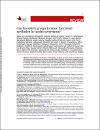Can bryophyte groups increase functional resolution in tundra ecosystems?
| Author | Lett, Signe |
| Author | Jónsdóttir, Ingibjörg S. |
| Author | Becker-Scarpitta, Antoine |
| Author | Christiansen, Casper T. |
| Author | During, Heinjo |
| Author | Ekelund, Flemming |
| Author | Henry, Gregory H.R. |
| Author | Lang, Simone I. |
| Author | Michelsen, Anders |
| Author | Rousk, Kathrin |
| Author | Alatalo, Juha M. |
| Author | Betway, Katlyn R. |
| Author | Rui, Sara B. |
| Author | Callaghan, Terry |
| Author | Carbognani, Michele |
| Author | Cooper, Elisabeth J. |
| Author | Cornelissen, J. Hans C. |
| Author | Dorrepaal, Ellen |
| Author | Egelkraut, Dagmar |
| Author | Elumeeva, Tatiana G. |
| Author | Haugum, Siri V. |
| Author | Hollister, Robert D. |
| Author | Jägerbrand, Annika K. |
| Author | Keuper, Frida |
| Author | Klanderud, Kari |
| Author | Lévesque, Esther |
| Author | Liu, Xin |
| Author | May, Jeremy |
| Author | Michel, Pascale |
| Author | Mörsdorf, Martin |
| Author | Petraglia, Alessandro |
| Author | Rixen, Christian |
| Author | Robroek, Bjorn J.M. |
| Author | Rzepczynska, Agnieszka M. |
| Author | Soudzilovskaia, Nadejda A. |
| Author | Tolvanen, Anne |
| Author | Vandvik, Vigdis |
| Author | Volkov, Igor |
| Author | Volkova, Irina |
| Author | van Zuijlen, Kristel |
| Available date | 2023-02-15T05:16:28Z |
| Publication Date | 2022-09-01 |
| Publication Name | Arctic Science |
| Identifier | http://dx.doi.org/10.1139/as-2020-0057 |
| Citation | SigneLett, Ingibjörg S.Jónsdóttir, AntoineBecker-Scarpitta, Casper T.Christiansen, HeinjoDuring, FlemmingEkelund, Gregory H.R.Henry, Simone I.Lang, AndersMichelsen, KathrinRousk, Juha M.Alatalo, Katlyn R.Betway, Sara B.Rui, TerryCallaghan, MicheleCarbognani, Elisabeth J.Cooper, J. Hans C.Cornelissen, EllenDorrepaal, DagmarEgelkraut, Tatiana G.Elumeeva, Siri V.Haugum, Robert D.Hollister, Annika K.Jägerbrand, FridaKeuper, KariKlanderud, EstherLévesque, XinLiu, JeremyMay, PascaleMichel, MartinMörsdorf, AlessandroPetraglia, ChristianRixen, Bjorn J.M.Robroek, Agnieszka M.Rzepczynska, Nadejda A.Soudzilovskaia, AnneTolvanen, VigdisVandvik, IgorVolkov, IrinaVolkova, and Kristel vanZuijlen. Can bryophyte groups increase functional resolution in tundra ecosystems?. Arctic Science. 8(3): 609-637. https://doi.org/10.1139/as-2020-0057 |
| Abstract | The relative contribution of bryophytes to plant diversity, primary productivity, and ecosystem functioning increases towards colder climates. Bryophytes respond to environmental changes at the species level, but because bryophyte species are relatively difficult to identify, they are often lumped into one functional group. Consequently, bryophyte function remains poorly resolved. Here, we explore how higher resolution of bryophyte functional diversity can be encouraged and implemented in tundra ecological studies. We briefly review previous bryophyte functional classifications and the roles of bryophytes in tundra ecosystems and their susceptibility to environmental change. Based on shoot morphology and colony organization, we then propose twelve easily distinguishable bryophyte functional groups. To illustrate how bryophyte functional groups can help elucidate variation in bryophyte effects and responses, we compiled existing data on water holding capacity, a key bryophyte trait. Although plant functional groups can mask potentially high interspecific and intraspecific variability, we found better separation of bryophyte functional group means compared with previous grouping systems regarding water holding capacity. This suggests that our bryophyte functional groups truly represent variation in the functional roles of bryophytes in tundra ecosystems. Lastly, we provide recommendations to improve the monitoring of bryophyte community changes in tundra study sites. |
| Sponsor | This study was supported by a grant to SL from the European Union’s Horizon 2020 research and innovation programme under the Marie Sklodowska-Curie, Grant No. 797446 and by the Independent Research Fund Denmark, Grant no. 0135-00140B. Funding from the Academy of Finland (grant 322266), National Science Foundation (1504224, 1836839, PLR-1504381 and PLR-1836898), Independent Research Fund Denmark (9040-00314B), Moscow State University, (project No 121032500089-1), Natural Sciences and Engineering Research Council of Canada, ArcticNet, Polar Continental Shelf Program, Northern Science Training Program, Polar Knowledge Canada, Royal Canadian Mounted Police, Tomsk State University competitiveness improvement program and the Russian Science Foundation (grant No 20-67-46018) are gratefully acknowledged. Matthias Ahrens provided valuable insights on the cushion growth form, and we are most thankful. We thank Gaius Shaver and two anonymous reviewers for providing valuable critique and input to earlier versions of this manuscript. |
| Language | en |
| Publisher | Canadian Science Publishing |
| Subject | Arctic–Alpine environmental change functional traits mosses water holding capacity |
| Type | Article Review |
| Issue Number | 3 |
| Volume Number | 8 |
| ESSN | 2368-7460 |
Files in this item
This item appears in the following Collection(s)
-
Earth Science Cluster [217 items ]


